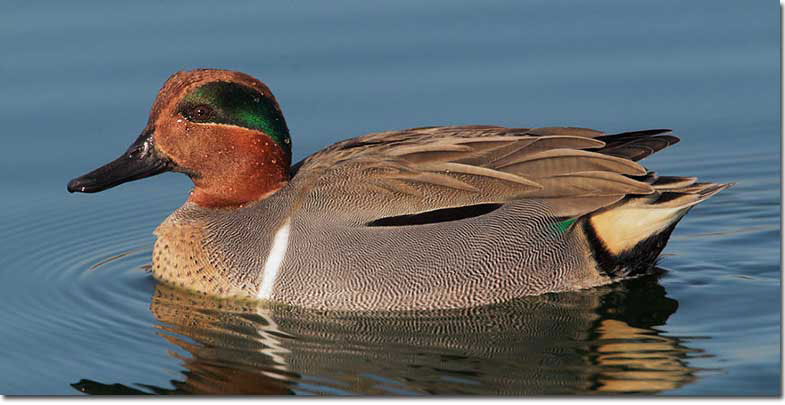The Green-winged Teal is North America’s smallest dabbling duck species. These ducks are named after the striking emerald-green patch on their wings, which contrasts beautifully with their gray bodies and chestnut head.
You may find them in various habitats near bodies of water, skimming the water for food or poking mud for prey.
On this page
Identification
Green-winged Teals are one of the smallest ducks in North America with short and blocky bodies and large heads. They measure 12.2-15.3 inches long, weigh around 4.9-17.6 ounces, and have a wingspan of 20.5-23.2 inches.
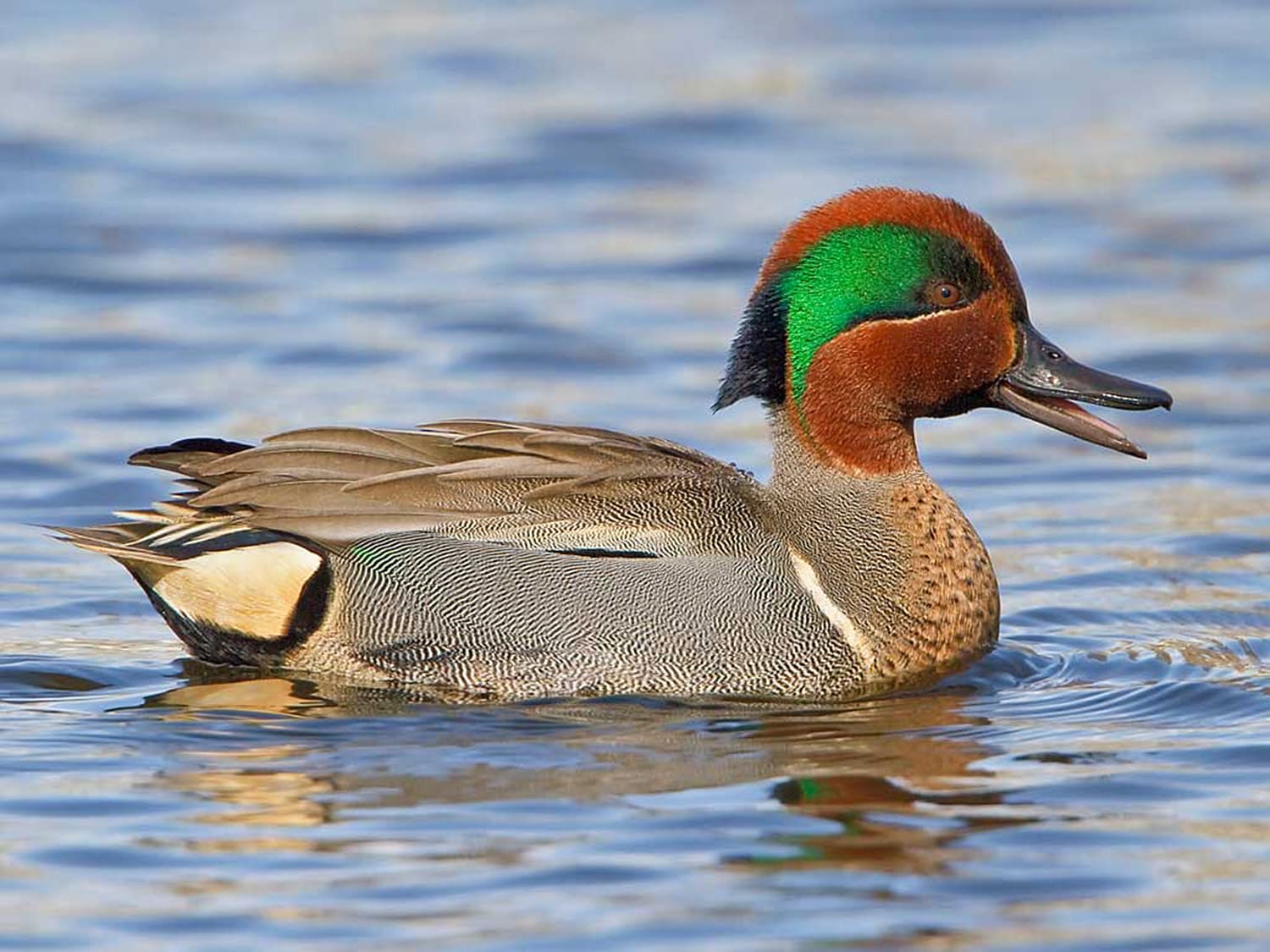
Photograph © Glenn Bartley.
Male Green-winged Teals have breeding plumage and non-breeding (also known as eclipse) plumage.
In their breeding plumage, they have a gray body, a pale underside with dark spots, a cinnamon-colored head and neck with a green patch extending from the eye toward the back of the neck, and a black bill. They also have a vertical white stripe on the side of their bodies right in front of their wings. Males in eclipse plumage look similar to females.
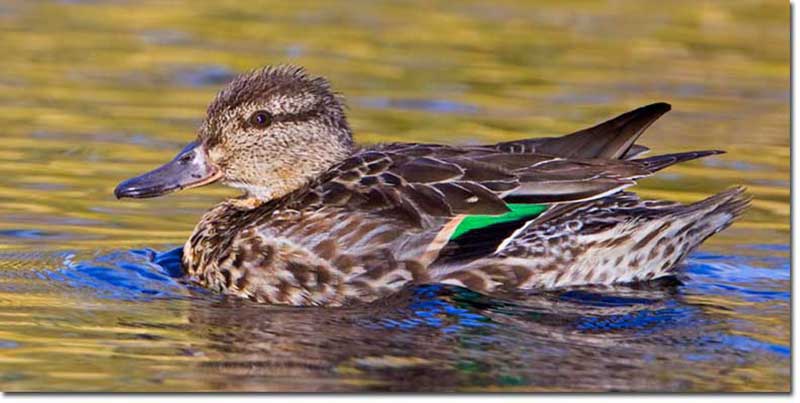
Female Green-winged Teal
Female Green-winged Teals are mottled in shades of brown, cinnamon, and tan. Their heads are lighter whereas, their bodies are a bit darker, and their undersides are pale.
The top of their head is darker brown, and they have a narrow horizontal brown stripe extending from their eyes toward the back of their head. Both the male and female have whitish gray underwings and a green speculum best seen while they’re flying. Juvenile Green-winged Teals look similar to females.
Green-winged Teals mostly call while in groups and not flying. Males make peeping sounds, melodic far-carrying whistles, and low-pitched trills. Females show contentment by letting out several quacks that go quieter and quieter. Both sexes may also squeal and give general quacks.
Food
Green-winged Teals are opportunistic omnivores, mostly feeding on plant matter. Their diet differs with location and season.
The plant part of their diet consists of seeds of grasses, pondweeds, and sedges, grains such as rice, corn, barley, nuts, algae, and different aquatic plants. Insects, aquatic and terrestrial worms, crustaceans, insect larvae, mollusks, tadpoles, and fish eggs comprise the animal part of their diet.
Green-winged Teals prefer to feed on mudflats, but they also forage in shallow water, near the shore, and in agricultural fields.
They may feed both at night and during the day. Their winter diet mostly consists of seeds whereas in the summer they feed more on animal matter.
Green-winged Teals’ foraging behavior varies throughout their life. It is affected by various factors such as migration, weather, and energy demands. They may swim in shallow water, filtering water and mud with their bills which are lined with fine comb-like bristles called lamellae that they use to trap food. They may also up-end, pick items from the water’s surface, and probe mudflats for prey.
If food is scarce, they may spend more than twice the time foraging and when feeding in groups, they may be less vigilant.
Nesting and Eggs
Green-winged Teals are monogamous with the female doing the bulk of the work. These teals start forming pairs in fall with males trying to impress females by bobbing their heads up and down, throwing them backward, and raising their chests. The male picks a female and forces copulation.
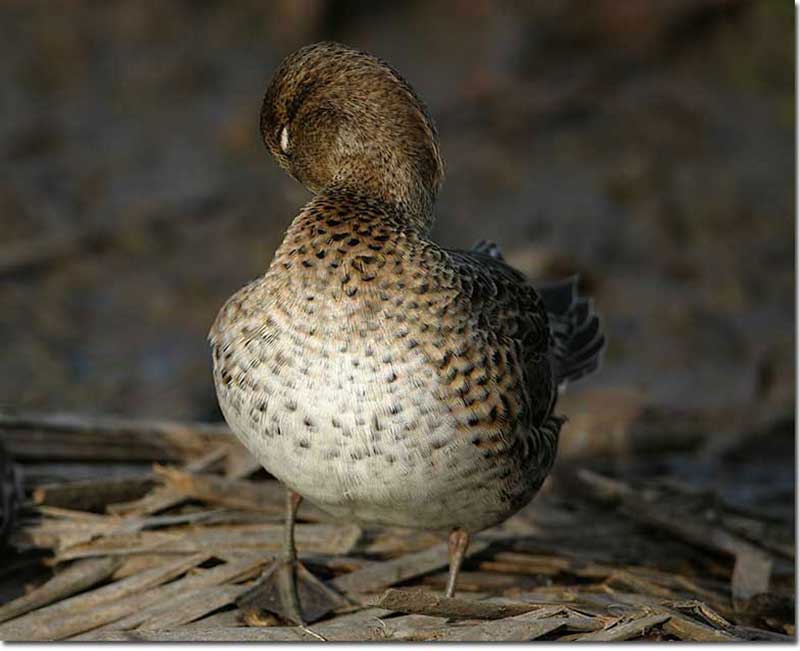
Green-winged Teals nest on the ground. Female picks the site, which is usually within 200 yards of water in grasslands, sedge meadows, brush thickets, or woods well hidden in grasses and weeds that offer dense cover.
The mother bird scrapes a nest bowl, lays the first egg, and then adds plant material like leaves and twigs. She lays one egg per day. After the last egg has been laid, the hen lines the nest with her down feathers and starts incubating.
There may be 6-11, up to 18 eggs in a clutch on rare occasions. Green-winged Teal eggs may be creamy white, pale buff, or even pale olive in color and measure around two inches long and 1.3-1.4 inches wide.
The female incubates the eggs for 20-24 days. The offspring leave the nest a few hours after hatching but may return for the first few nights.
As with most duck species, the younglings find their own food under their mother’s careful gaze. Young Green-winged Teals fledge at around 35 days after hatching.
Current Situation
Green-winged Teals range throughout North and Central America with most of its population being migratory and some resident. Their breeding range covers Alaska and Canada and extends into the northern United States.
These teals can be found year-round in the Aleutian Islands and parts of Colorado, Utah, and Nevada. Birds from the northern part of the range migrate to the southern and eastern parts of the United States and as far as Central America for the winter.
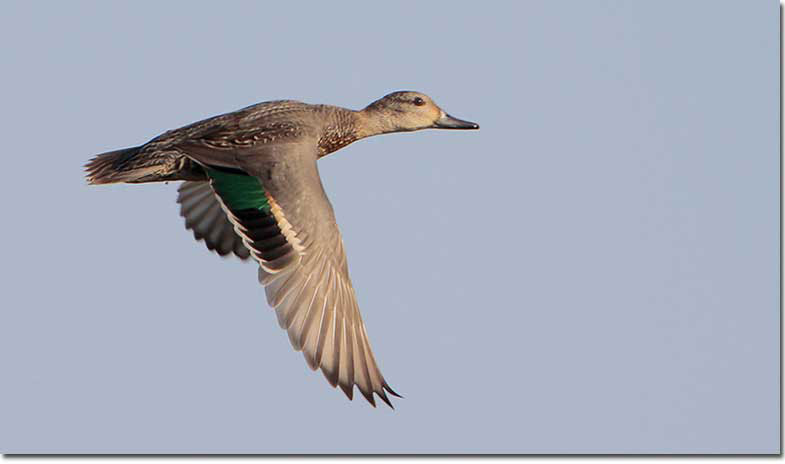
Green-winged Teals inhabit various habitats near bodies of water. During the breeding season, these include marshes, rivers, bays, and open country near shallow freshwater lakes. They can be found in shallow lakes and inland pools with standing or floating vegetation, coastal estuaries, and tidal marshes during migration and winter.
Green-winged Teals are listed as of least concern on the IUCN Red List. Even though they’re a popular game bird, their population is still slightly increasing.
Facts
- There is some debate over whether the American Green-winged Teal (Anas carolinensis) is the same species as the Eurasian Green-winged Teal (Anas crecca). Some sources handle them as separate species whereas others as the same, although there are differences in plumage, range, and other characteristics.
- It is rather uncommon for adult Green-winged Teals to fall prey, although their eggs are at a rather high risk of predation. If it is known that the area has predators in it or nearby, then individuals prefer to forage in groups and spend most of their time surveying their surroundings rather than eating. If needed, they will dive to escape predators.
- Green-winged Teals are one of the fastest fliers among game birds. Their usual flight speed is 50 mph, and they are capable of reaching speeds up to 60 mph.
- When you see a Green-winged Teal scratch its bill, it is most probably done to clean its nasal passages from obstructions, such as leeches.
- Ducks, including Green-winged Teals, have up to 12,000 individual skin muscles they use to manipulate their feathers. These muscles enable the birds to adjust their plumage in various manners to regulate body temperature and express emotion.
Similar Species
When birdwatching waterfowl, you may mistake some duck species for the Green-winged Teal. We have introduced three of them and brought out their differences.
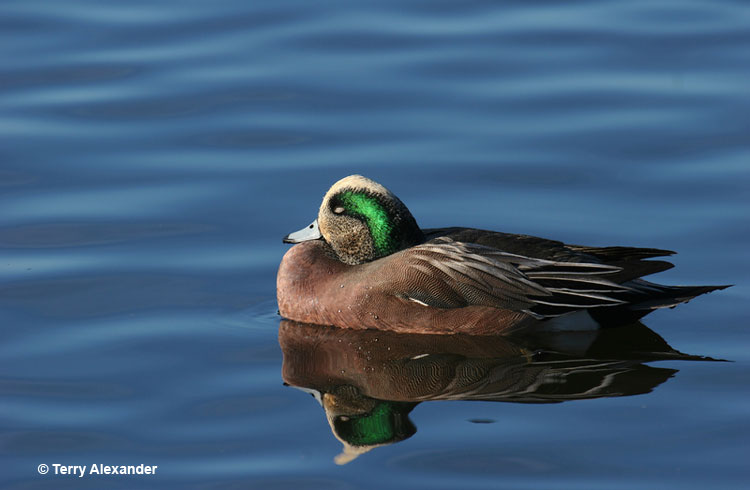
American Wigeon
Male Green-winged Teals and American Wigeons have the same body shape and even the green eye patch.
However, male American Wigeons have a pale cinnamon body and pale buffy head and neck with dark speckling instead of a gray body and chestnut-colored head and neck. Their beak is whitish instead of black and they lack the white vertical stripe in front of their wings that the Green-winged Teal has.
Females are rather similar, but female American Wigeons are paler and have a shorter and paler bills.
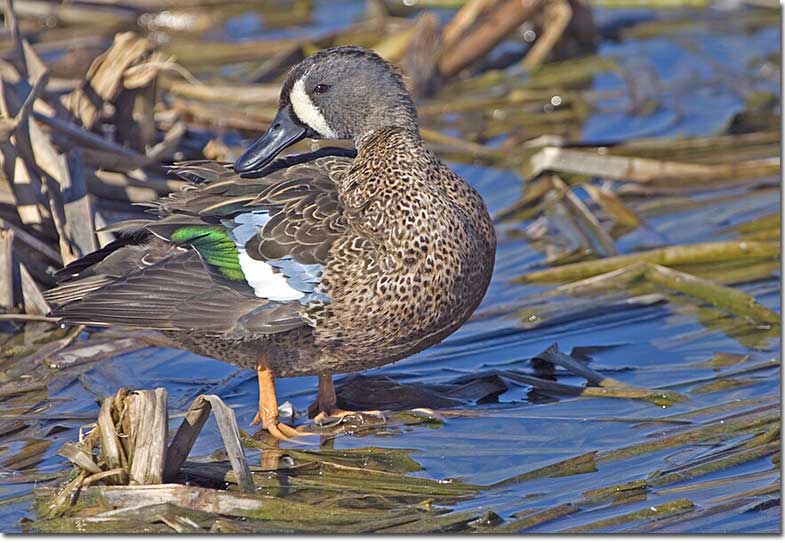
Blue-winged Teal
Male Blue-winged teals have a buffy body with dark speckles instead of a gray body. Their heads are dark bluish-gray instead of chestnut and green, and they have a white vertical stripe in front of their eyes.
Blue-winged Teals lack the vertical white stripe in front of their wings. If you see one flying and they have a pale blue wing patch, then it’s a Blue-winged Teal.
Females are very similar, but Blue-winged Teals are paler and duller and lack the pale stripe at the rear.
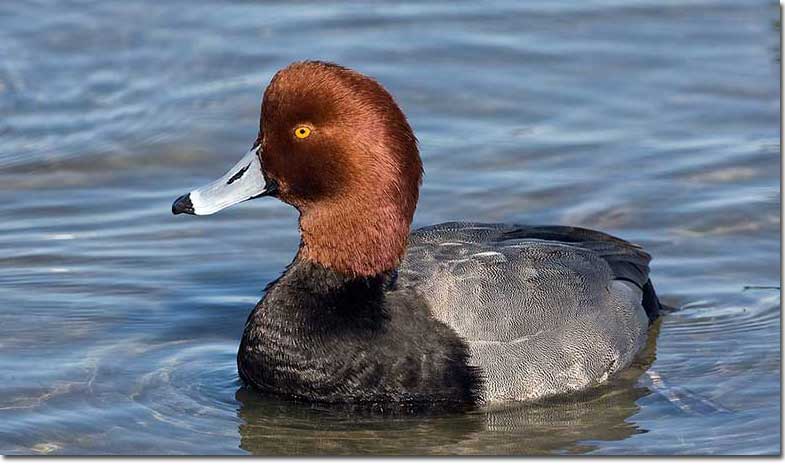
Redhead
Male Redheads and Green-winged Teals have similar gray bodies and chestnut heads.
However, Redheads are bigger and have a black chest, yellow eyes, and grayish beak, and lack the green patch on their heads.
While female Green-winged Teals are mottled in different shades of brown and tan, then female Redheads are medium brown overall.
Frequently Asked Questions
What is the difference between a Teal and a Green-winged Teal?
Green-winged Teals look different than most other teals. Males can be recognized by their small, blocky, and gray body, chestnut head and neck, and a green patch on their faces, green speculums, and the white vertical stripe in front of their wings.
What are the characteristics of a Green-winged Teal?
Male Green-winged Teals have a gray body, a pale underside with dark spots, a chestnut head and neck, green patches on their face, green speculums, and a white vertical stripe in front of their wings. Females are mottled brown and have dark bills.
Where are Green-winged Teals found?
Green-winged Teals can be seen all across North and Central America near various bodies of water, including rivers, shallow freshwater lakes and ponds, estuaries, bays, marshes, and more.

